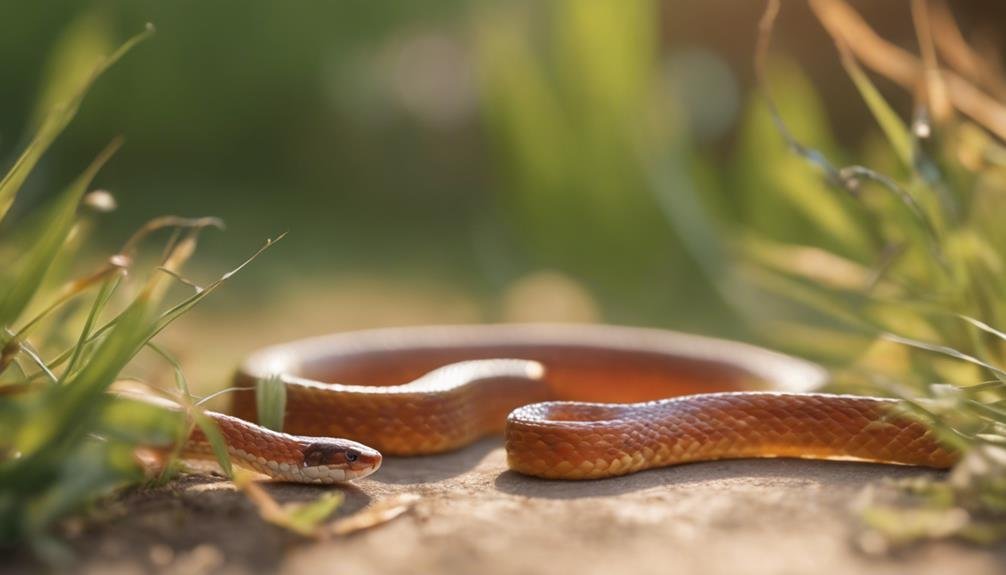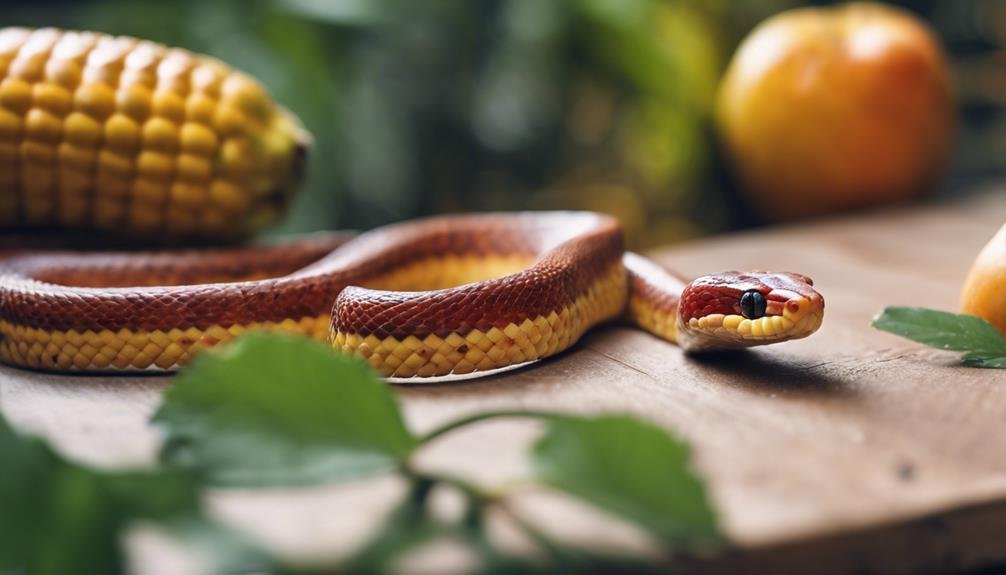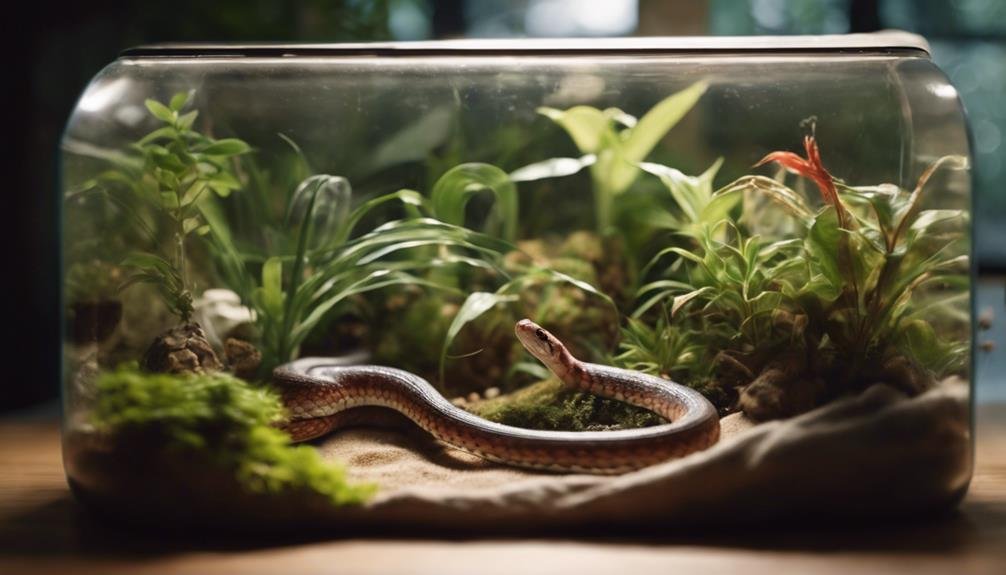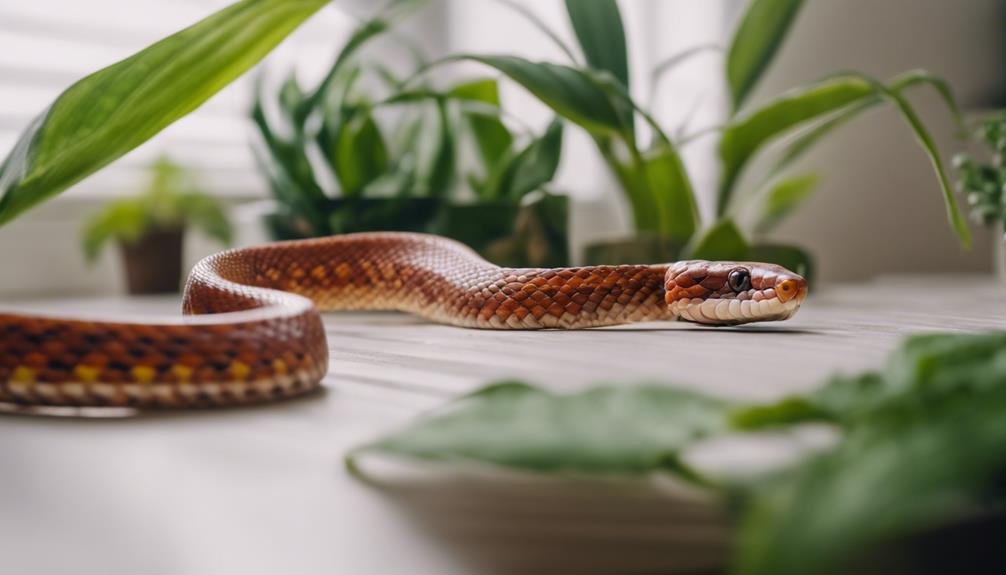As you explore the world of corn snakes, you might find yourself wondering if there's such a thing as too big for these slithery companions. Typically ranging from 3.5 to 4.5 feet, they're known for their manageable size, but what happens when they exceed the norm? While maintaining their health within a 200-475g weight range is key, factors like diet and habitat play a vital role in their growth. But before you get too concerned about your corn snake outgrowing its welcome, consider what influences their size and how you can make sure they remain just the right size for both of you. Let's uncover the balance between natural growth and the potential for excessive size.
Key Takeaways
- Corn snakes typically grow to an average size of 3.5ft to 4.5ft in length.
- Males often outgrow females, reaching up to 6 feet in rare cases.
- Growth rates vary, with significant growth in the early years and slowing after age 5.
- Genetics, environmental conditions, and hybridization with rat snake species can affect size.
- Regular health and habitat management ensure growth within the healthy range, avoiding "too big" sizes.
Understanding Corn Snake Growth
In order to grasp how big a corn snake can get, it's important to understand that their growth varies, with males typically outgrowing females and sizes peaking at around 3.5ft to 4.5ft on average. While you might hear tales of corn snakes reaching up to 6ft, and even claims of 7ft, these are exceptions or likely due to overestimations. The growth rates of these creatures aren't uniform; they differ from one snake to another.
As your corn snake ages, you'll notice its growth spurting significantly during the early years, especially before it hits the 5-year mark. After this age, don't expect the rapid growth you've seen; it slows down quite a bit. However, it's fascinating to note that corn snakes continue to grow throughout their lives, albeit at a snail's pace compared to their youthful vigor. This means older corn snakes tend to be longer, contributing to the average size you're likely to encounter.
Factors Affecting Size
Several factors play a role in determining how big your corn snake might grow, from genetics to environmental conditions. You'll find that male corn snakes often outsize their female counterparts, which is one of the primary contributors to size variations within the species. When it comes to growth rates, there's a significant range among individual snakes, meaning some might reach their maximum size quicker than others.
It's important to note that while corn snakes continue to grow throughout their lives, this growth substantially slows after the first five years. This means that the size your snake reaches at this milestone will be close to its size for the remainder of its life, although some gradual increase is still possible.
Hybridization plays a curious role in the sizes you might see. Corn snakes that have interbred with rat snake species can reach sizes larger than what you'd typically expect. However, it's wise to take tales of 7ft corn snakes with a grain of salt, as these claims are often exaggerated. The actual length of your corn snake can be somewhat unpredictable, but understanding these factors can help manage your expectations regarding its final size.
Average Adult Sizes


Understanding how factors like genetics and environment impact size, let's now focus on what you can typically expect from the average adult corn snake. Corn snakes, with their striking patterns and manageable size, have become a favorite among reptile enthusiasts. The average adult sizes of these creatures are quite reasonable for most snake owners, contributing to their popularity.
Adult corn snakes typically range between 3.5ft and 4.5ft in length. It's fascinating to observe that males usually outsize females, a common trait among many snake species. However, their growth rates tell a more nuanced story. After reaching the age of 5, the growth rate of corn snakes slows significantly. This means that while they continue growing throughout their lives, older corn snakes won't grow as rapidly as their younger counterparts.
Here's a quick glance at what you can expect:
| Length Range | Common Observation |
|---|---|
| 3.5ft to 4.5ft | Typical adult size |
| Up to 5ft | Average maximum length |
| 7ft | Likely exaggerated claims |
These figures highlight that while you might hear tales of giant corn snakes, the truth is they remain a comfortably sized pet for many.
Record Sizes Documented
Corn snake enthusiasts might be surprised to learn that the largest recorded individuals have stretched up to an impressive 6 feet in length. While the average adult size is often a bit shorter, these rare exceptions challenge the typical expectations for this popular reptile. It's a thread of fascination in the corn snake community that sometimes, under just the right conditions, these creatures can grow notably larger than anticipated.
However, it's important to approach claims of corn snakes exceeding 6 feet, such as the often-mentioned but exaggerated 7-foot mark, with skepticism. Many of these claims lack the visual evidence necessary for accurate assessment, leading to misinterpretations.
- Hybridization with rat snake species: This genetic crossing can result in larger-than-average corn snakes, adding an interesting twist to the size potential of these reptiles.
- Visual evidence is key: To authentically document record sizes, clear photographic or video proof is essential, ensuring that claims are credible.
- Rare exceptions exist: While most corn snakes won't reach these record lengths, the exceptions provide a fascinating glimpse into the potential size range of the species, pushing the envelope of what's considered typical for this beloved reptile.
Health and Weight Management


Monitoring your corn snake's weight and body condition regularly is essential for maintaining its health. Adult corn snakes should ideally weigh between 200-475g. Those tipping the scales over 500g might be considered overweight, and it's important to address this through proper weight management. A consistent feeding schedule plays a significant role in ensuring your snake doesn't become obese or underweight. Observing the size of your snake's head in relation to its body can also provide clues about its overall health; a disproportionately small head might indicate obesity.
To keep your corn snake in top condition, balanced nutrition, appropriate husbandry, and regular vet check-ups are key components of a thorough weight management strategy. Here's a quick reference table to help you gauge the health of your corn snake at a glance:
| Indicator | Healthy Range | Notes |
|---|---|---|
| Weight | 200-475g | Over 500g might be overweight |
| Body Condition | Proportional head/body | Disproportion suggests obesity |
| Feeding Schedule | Consistent | Adjust based on weight and condition |
Diet's Role in Growth
A well-balanced diet is essential for your corn snake's growth and overall size. Understanding the diet's role in growth is important for raising a healthy, vibrant snake. Feeding your snake with the appropriate prey size for its age and size not only guarantees healthy growth but also prevents potential health issues. It's important to adjust the size of the prey as your snake grows; what was suitable for a juvenile snake mightn't suffice for an adult.
To optimize your corn snake's growth through its diet, consider the following:
- Appropriate Prey Size: Always match the prey size to your snake's current size to encourage proper feeding and digestion.
- Avoid Live Prey: Opting for pre-killed prey can prevent injuries to your snake, ensuring a safer feeding response.
- Varied Diet: Incorporating varied prey items, like Reptilinks Mega Blend, can provide a more balanced diet and support excellent growth.
Monitoring your snake's feeding response and being willing to adjust the feeding schedule as needed are key. A keen observation of how your corn snake reacts to different prey sizes and types can inform you if your current feeding strategy is effective, or if it needs tweaking to better support your snake's growth trajectory.
Creating the Ideal Habitat


After exploring how diet influences growth, it's essential you shift your focus to creating the ideal habitat for your corn snake.
You'll need to make sure the temperature and humidity are just right, aiming for a basking area of 90 degrees Fahrenheit and a humidity range of 50% to 65%.
Adding essential elements like climbing spaces and hiding spots won't only make the enclosure comfortable but also stimulate your snake's natural behaviors.
Optimal Temperature Ranges
Creating the ideal habitat for your corn snake requires maintaining the basking area at around 90 degrees Fahrenheit. Achieving the perfect temperature ranges and humidity levels is vital for their health and activity. It's not just about the right temperature; making sure that the humidity levels are kept between 50% and 65% plays a significant part in mimicking their natural environment and promoting overall well-being.
To dive deeper:
- Monitor and regulate the basking area's temperature to guarantee it stays close to 90 degrees Fahrenheit.
- Maintain humidity levels between 50% and 65% to support shedding and respiratory health.
- Use digital thermometers and hygrometers for accurate monitoring, ensuring your snake's habitat remains within the ideal range for both temperature and humidity.
Essential Habitat Elements
To guarantee your corn snake thrives, it's essential to focus on the essential elements of its habitat, including proper vivarium size and the incorporation of vertical space. A four-foot vivarium is the recommended minimum for an adult, but aiming for a vivarium length equal to the snake's length ensures peak comfort. This approach not only meets their spatial needs but also allows for the inclusion of vertical space and branches, greatly enhancing their activity level and overall well-being.
Larger vivariums offer more room for movement and opportunities for enrichment, important for maintaining a healthy and stimulated corn snake. Historically, vivarium sizing was based on the snake's length or diagonal measurement, underscoring the importance of space for their physical and mental health.
Monitoring Your Snake's Size
Monitoring your corn snake's growth is essential for keeping track of its health and well-being. Regular check-ups allow you to observe its growth patterns and make sure it's not reaching an abnormal size, which could indicate health issues. It's not just about celebrating its milestones; it's about guaranteeing your pet is thriving under your care.
To effectively monitor your snake's size, consider these steps:
- Measure its length regularly: This helps you keep a close eye on how quickly your snake is growing. Use a flexible tape measure for accuracy, and try to do this when your snake is relaxed and straight.
- Watch for sudden size changes: Any rapid increase or decrease in size should be a red flag. It's important to take note of these changes and seek advice if they seem unusual.
- Compare against average lengths: Knowing the typical size range for adult corn snakes gives you a benchmark. If your snake deviates significantly from these norms, it might be time to consult with a vet.
Paying attention to your snake's body condition and overall health as it grows is essential. If you notice any signs of abnormal growth patterns or size discrepancies, don't hesitate to seek veterinary advice. This proactive approach ensures your corn snake remains healthy and happy throughout its life.
Is a Corn Snake’s Size Related to Its Pooping Frequency?
The corn snake poop cycle is not directly related to its size. Regardless of their size, corn snakes generally have a regular pooping frequency. Factors like their diet, activity level, and metabolism play a more significant role in determining when and how often they poop.
Conclusion
In essence, your corn snake's growth largely depends on genetics, care, and diet. Averaging 3.5 to 4.5 feet, they can occasionally outgrow expectations but rarely hit 6 feet. It's essential to monitor their size and weight, ensuring they don't become obese.
By providing a balanced diet and the right habitat, you'll help your snake thrive at a healthy size. Remember, regular vet visits are key to spotting any potential issues early, keeping your slithery friend just the right size.



[…] corn snake size and growth do not directly affect the incubation process for their eggs. Regardless of the snake’s size, […]